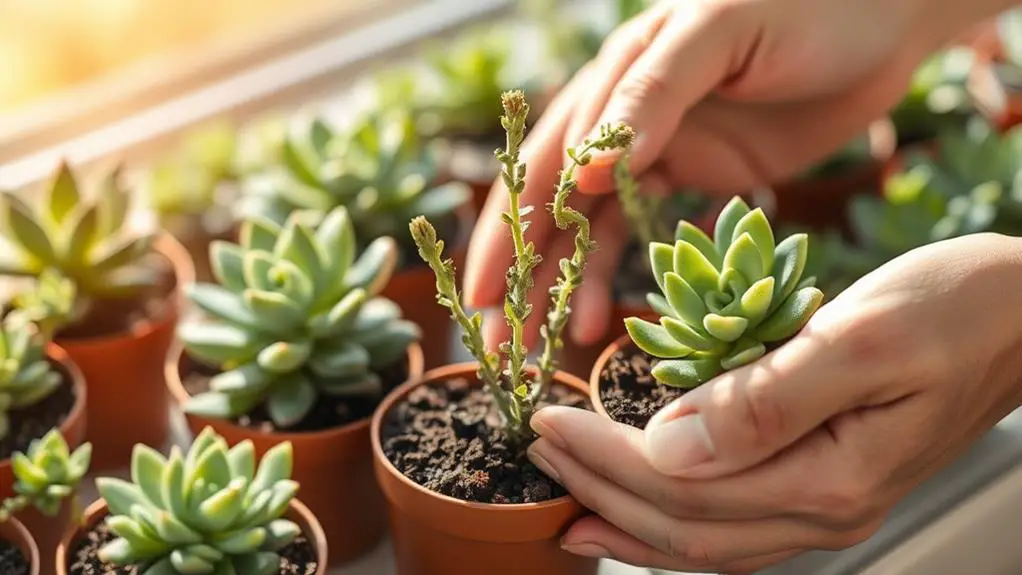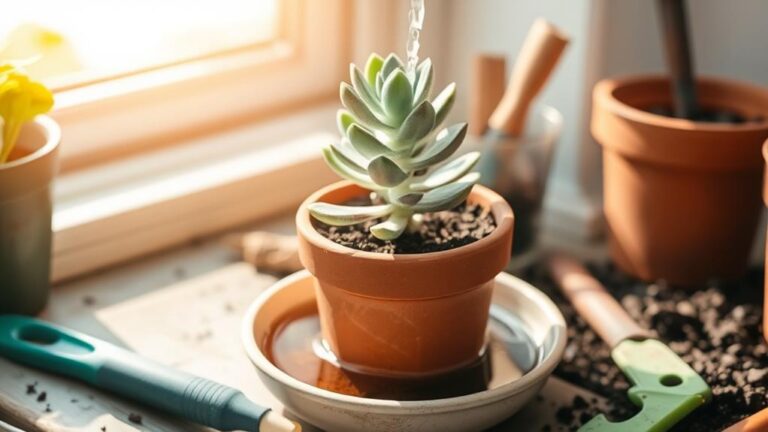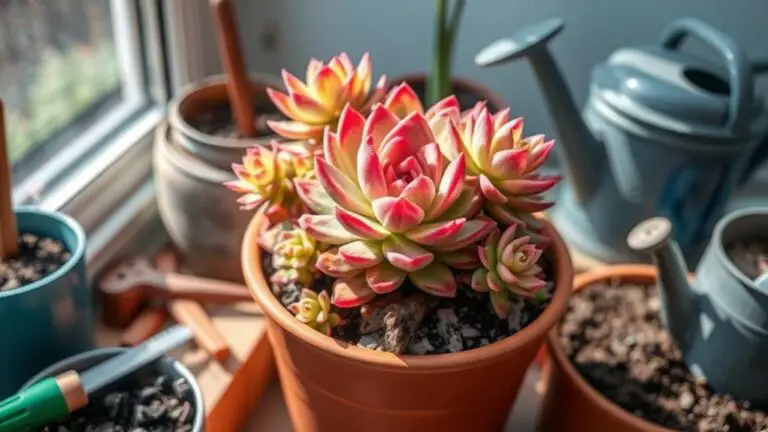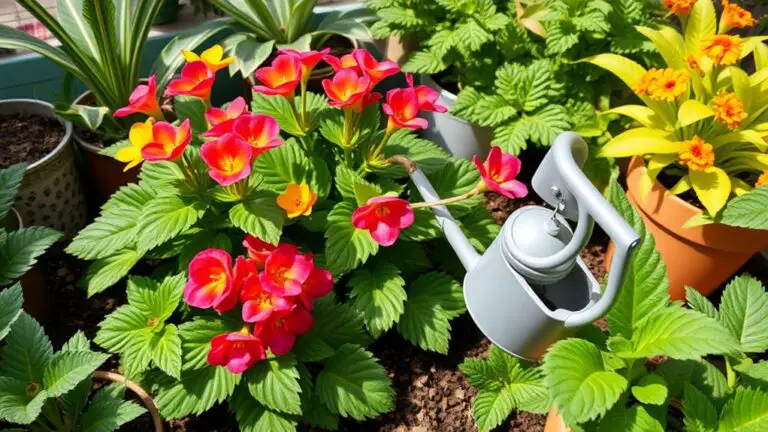7 Simple Steps to Propagate Crassula Succulents Successfully
When you want to propagate Crassula succulents successfully, you need to follow a series of steps to guarantee healthy growth. Start by choosing the right method and gathering the necessary supplies. Preparing your cuttings and allowing them to callus is vital before planting them in well-draining soil. Proper care, including infrequent watering and ample sunlight, is essential. But there's more to it—monitoring temperature and checking for pests are equally important. Wondering what else you might be missing? Let's take a closer look at each step to guarantee your Crassula cuttings thrive.
Choose the Right Method
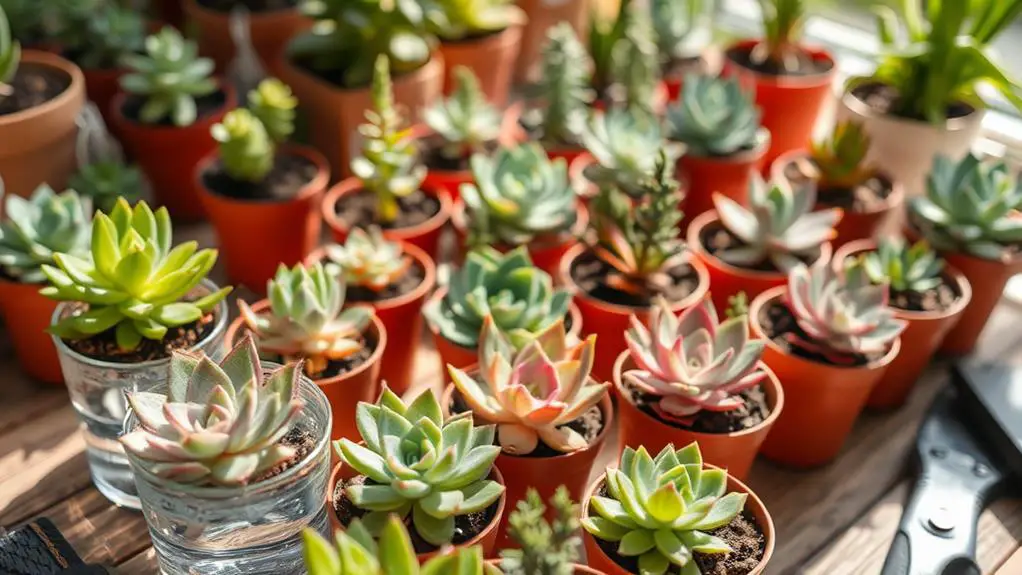
Choosing the right method to propagate your Crassula succulents is vital for guaranteeing a high success rate. You have a few options: stem cuttings, leaf cuttings, and division. Each method is effective, but choosing the right one depends on your plant and preference.
For stem cuttings, pick a healthy 3-6 inch stem from your Crassula. Let it callus for 1-2 days to prevent rot, then plant it in well-draining soil. This method is great for creating new plants because the stem will develop roots quickly.
Leaf cuttings are another excellent way to propagate succulents. Carefully remove a healthy leaf from the plant. Let the cut end dry for about 24 hours. Next, place the leaf on moist, well-draining soil. Make sure it gets bright, indirect sunlight. Soon, roots and tiny new plants will form at the base of the leaf.
Division works well if your Crassula produces offsets. Gently separate the offsets from the parent plant and let them air dry for 1-2 days. Then, replant them in suitable soil.
Timing is vital, so propagate during the active growing season in spring or summer for the best results.
Gather Necessary Supplies

To get started with propagating Crassula succulents, you'll need a few key items.
Use clean, sharp pruning shears or scissors for precise cuts, and prepare a well-draining potting mix to keep your cuttings healthy.
Don't forget pots with drainage holes, a spray bottle for misting, and labels to keep track of your progress.
Essential Propagation Tools
When propagating Crassula succulents, having the right tools at your disposal is vital for success. Start with a sharp knife or clean, sharp pruning shears to make precise cuts and minimize damage to the parent plant. This helps your cuttings grow strong and healthy.
Use a well-draining succulent and cactus soil mix, combining vermiculite or perlite with cactus soil to promote healthy growth and prevent root rot. Select pots with drainage holes to let excess water escape, reducing the risk of overwatering. Proper aeration guarantees your cuttings thrive.
Keep a spray bottle handy to lightly water and maintain humidity levels, which is important for rooting. Optional supplies include labels for tracking different cuttings and rooting hormone to enhance root development. While not always necessary, rooting hormone can give your propagation method a boost.
Place your cuttings in indirect sunlight, as too much direct light can harm them. Gather these tools and materials before starting, and you'll be ready to propagate your Crassula succulents successfully.
With the right preparation, you'll enjoy watching your new plants grow and flourish.
Ideal Soil Mix
Creating the ideal soil mix for your Crassula succulents is vital for fostering healthy growth and preventing root rot. You'll need a well-draining soil mix to make sure your plants thrive. Start with equal parts of cactus soil, perlite, and vermiculite. This combination helps maintain proper moisture levels and provides excellent drainage, important for Crassula propagation.
Don't worry about the pH level of the soil; it's not critical for Crassula succulents. Instead, focus on creating a sandy mix with some organic matter. This enhances drainage and aeration, allowing for healthy root development. You can even add small rocks to the mix to mimic the plant's natural arid environment, improving drainage further.
It's also important to use pots with drainage holes. These holes let excess water escape, lowering the risk of overwatering and root rot.
Regularly check the moisture levels in the soil by feeling the top inch. Only water your Crassula when it's completely dry to maintain the ideal conditions for propagation.
Prepare Your Cuttings
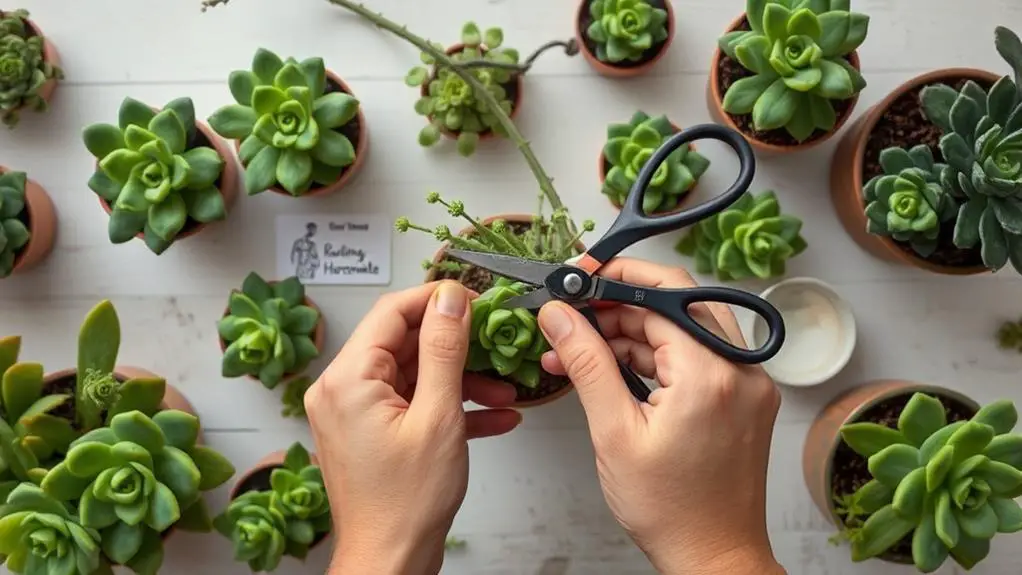
To start preparing your Crassula cuttings, choose healthy stems or leaves that are mature and free from pests or disease.
Cut a 3-6 inch section just below a leaf node using clean, sharp shears for stem cuttings, or remove an entire leaf with its base intact.
Let the cuttings dry and callus in a dry, shaded area for 1-3 days to reduce the risk of rot before planting.
Selecting Healthy Cuttings
Selecting healthy cuttings is vital for successful Crassula propagation. Start by choosing cuttings from healthy, mature Crassula plants. Make certain the plants are free from pests and diseases to maximize your success.
For stem cuttings, pick a section about four inches long that includes multiple leaves. Cut just below a leaf node, as this increases the chances of rooting. When taking leaf cuttings, make sure the leaf is fully intact and healthy. Damaged or immature leaves have a lower success rate for rooting.
Use clean, sharp tools to avoid tearing the plant tissue. Tearing can lead to infection and reduce the likelihood of successful propagation.
Once you've made your cuts, allow the cuttings to callus for 1-2 days in a dry, shaded area. This step is essential as it helps prevent rot and promotes healthy root development.
Drying and Callusing
After taking your Crassula cuttings, it's important to allow them time to dry and callus for 1-2 days. This step is essential to prevent rot and guarantee successful propagation.
Place your cuttings in a warm, dry area away from direct sunlight. It's significant to keep them on a clean, flat surface to avoid any moisture buildup, which can lead to rot.
During this period, the cut ends will form a callus, a protective layer that promotes healing. This callus is crucial because it aids in root development once the cuttings are planted.
To achieve ideal results, check your cuttings after a couple of days. You want them to feel firm and dry to the touch before moving forward.
Once the cuttings have properly callused, plant them in well-draining soil. Well-draining soil is key to preventing rot and promoting healthy root growth in your succulent.
Allow Cuttings to Callus
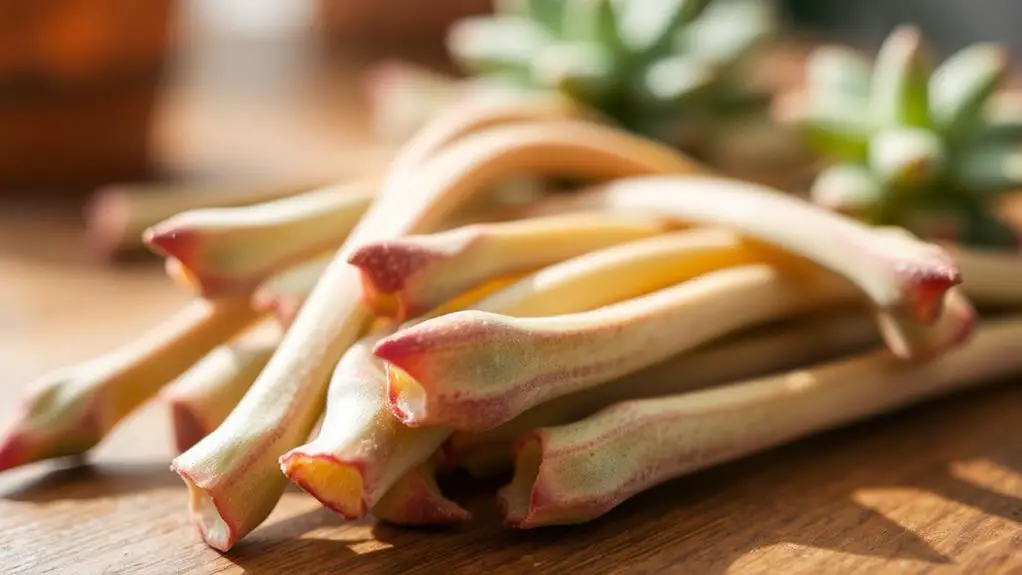
Making certain your Crassula cuttings have time to callus is an essential step in successful propagation. When you allow cuttings to callus, you help reduce the risk of rot and create a protective layer over the cut surface. This protective layer is vital because it helps prevent fungal infections, which can be a real problem during propagation.
Typically, the ideal callusing time for most Crassula succulents ranges from 3-4 days.
To set your cuttings up for success, follow these simple steps:
- Place the cuttings in a dry, warm location.
- Confirm there's good air circulation around the cuttings.
- Let them rest undisturbed for about 1-2 days before checking.
- If you're unsure, waiting up to 4 days can be beneficial for most species.
Plant in Well-Draining Soil
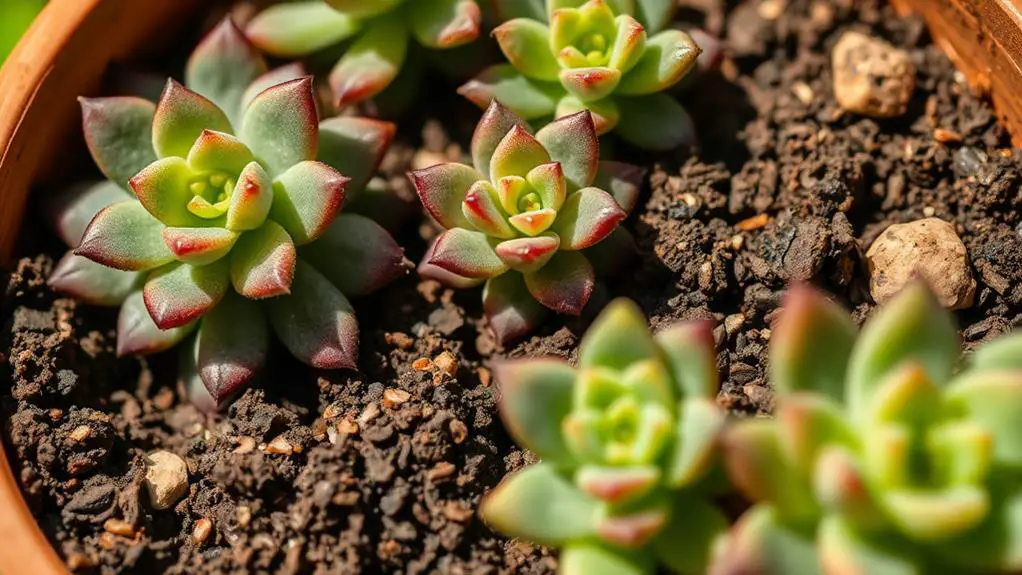
Once your Crassula cuttings have properly callused, it's time to plant them in well-draining soil. This type of soil is vital because it allows excess moisture to escape quickly, preventing root rot.
To create the ideal mix, combine equal parts cactus soil and either perlite or vermiculite. This blend guarantees excellent drainage and aeration, which are essential for healthy root development.
Before you plant the cuttings, verify that the soil is dry to the touch. This encourages root formation and minimizes the risk of fungal diseases.
Place the cuttings gently into the soil, making certain the roots have enough space to grow.
Using pots with drainage holes is equally important. These holes let excess water drain out, preventing it from accumulating at the bottom and causing root issues.
Avoid heavy potting mixes that retain moisture; Crassula succulents thrive in a sandy, light medium.
Provide Proper Care
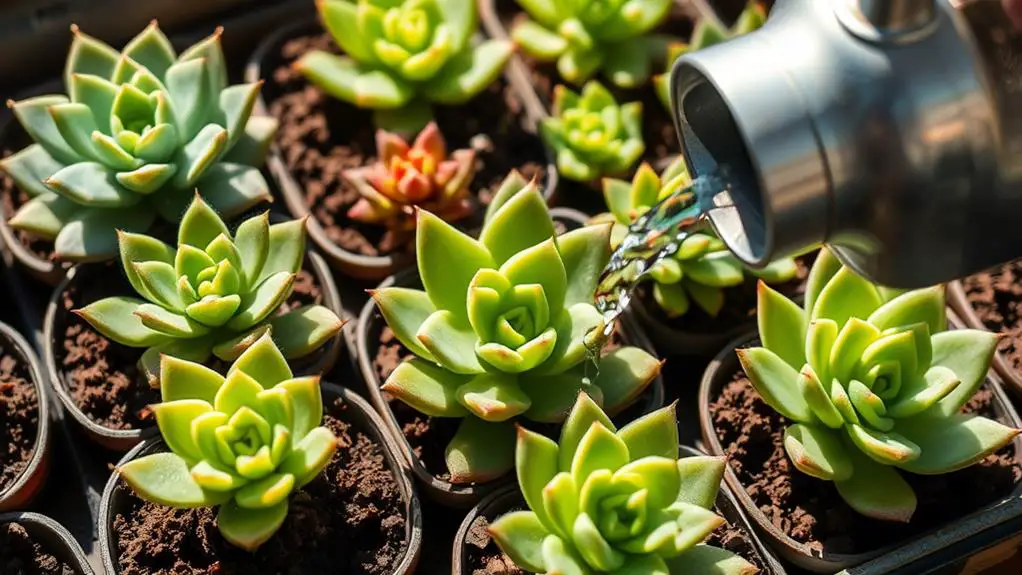
Caring for your Crassula succulents involves providing the right balance of light, water, and temperature. These plants thrive in full sunlight but can also tolerate bright, indirect sunlight.
Make sure they get enough light to avoid leggy stems. When propagating Crassula succulents, the right care is vital for their successful rooting and growth.
Key Care Tips:
- Water deeply but infrequently: Let the soil dry out completely between watering sessions. Overwatering can lead to root rot.
- Use well-draining soil: A mix of sand, peat moss, and organic matter works best to prevent water retention.
- Maintain temperatures: Keep daytime temperatures between 65-75°F and nighttime temperatures between 50-55°F for ideal growth.
- Monitor humidity levels: During plant propagation, high humidity is essential. Consider covering pots to maintain the right humidity.
Monitor for Growth
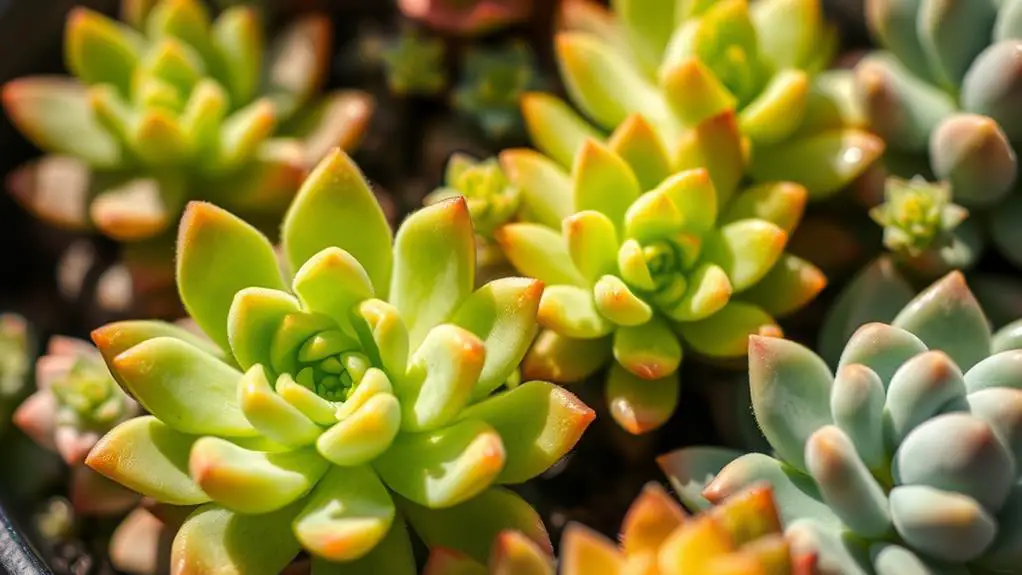
Providing proper care for your Crassula succulents sets the stage for successful propagation. Now, it's time to monitor for growth. Start by checking your cuttings or leaves for root development, which usually happens within 2-4 weeks if conditions are right.
Keep an eye on the soil moisture; it should be lightly damp, not soggy. Too much water can cause root rot, hindering growth.
Look for signs of new growth, like small leaves or roots sprouting. These are good indicators that your propagation efforts are working!
Make certain your Crassula succulents are in a stable environment with bright, indirect light and moderate humidity. Fluctuations in these conditions can slow down growth and affect plant health.
Regularly inspect your plants for pests or stress signs, such as yellowing leaves. These issues need immediate attention to guarantee continued growth.
Frequently Asked Questions
How to Propagate Crassula Succulent?
To propagate Crassula succulents, take a 4-inch stem cutting, let it callus for 1-2 days, then plant in well-draining soil. Lightly water. For leaves, let them dry 24 hours before placing on soil.
How Do You Propagate Succulents for Beginners?
To propagate succulents for beginners, start by taking healthy cuttings, let them callus for a few days, then plant in well-draining soil. Keep the soil lightly moist, place in indirect light, and watch for new growth.
Is It Better to Propagate a Jade Plant in Water or Soil?
You should propagate a jade plant in soil rather than water. Soil propagation promotes stronger root development and reduces the risk of rot. Using a well-draining succulent-specific potting mix guarantees your cuttings establish and grow healthily.
Can You Put Succulent Cuttings Straight Into Soil?
You can put succulent cuttings straight into soil, but let the cut ends dry for 1-2 days first. Use well-draining soil, water lightly, and provide bright, indirect light to help the cuttings establish roots without rotting.
Conclusion
You've got this! By following these seven simple steps, you'll be well on your way to propagating Crassula succulents successfully. Just remember to choose healthy cuttings, let them callus, and plant in well-draining soil. With proper care and a bit of patience, your succulents will thrive. Keep an eye on them, and don't forget to check for roots and pests. Happy gardening, and enjoy watching your plants grow! You're doing great!

